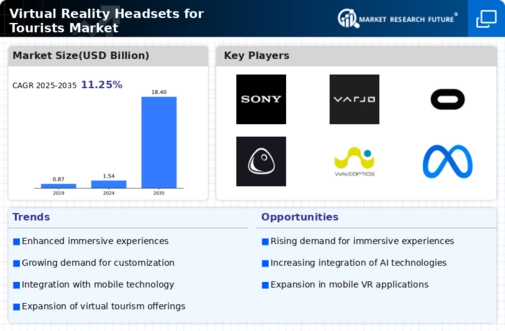Rise of Social Media Influence
The influence of social media on travel choices is a significant driver for the Virtual Reality Headsets for Tourists Market. As users share their immersive VR experiences online, they inspire others to seek similar adventures. This phenomenon creates a ripple effect, where visually captivating content encourages potential tourists to explore destinations through VR. Market analysis indicates that social media platforms are increasingly featuring VR content, which enhances visibility for tourism providers utilizing this technology. Consequently, the Virtual Reality Headsets for Tourists Market is likely to benefit from the growing trend of social media-driven travel inspiration.
Technological Advancements in VR
The rapid evolution of technology plays a pivotal role in the Virtual Reality Headsets for Tourists Market. Innovations in hardware and software have led to the development of more sophisticated and user-friendly VR headsets. Enhanced graphics, improved motion tracking, and reduced latency contribute to a more immersive experience for users. According to recent data, the market for VR headsets is projected to grow significantly, with estimates suggesting a compound annual growth rate of over 30% in the coming years. This technological progress not only attracts tourists seeking unique experiences but also encourages tourism companies to invest in VR solutions, thereby expanding the Virtual Reality Headsets for Tourists Market.
Integration of VR in Travel Planning
The integration of Virtual Reality technology into travel planning is transforming the way tourists make decisions. The Virtual Reality Headsets for Tourists Market benefits from platforms that allow potential travelers to experience destinations virtually before making bookings. This capability not only aids in decision-making but also enhances customer confidence in their choices. Data suggests that travelers who engage with VR content are more likely to book trips, as they can visualize their experiences. As travel agencies and platforms increasingly adopt VR tools, the Virtual Reality Headsets for Tourists Market is expected to grow, driven by the demand for enhanced pre-travel engagement.
Growing Demand for Unique Experiences
As travelers increasingly seek unique and memorable experiences, the Virtual Reality Headsets for Tourists Market is witnessing a surge in demand. Tourists are drawn to immersive experiences that allow them to explore destinations in innovative ways. This trend is reflected in the rising popularity of VR tours, which offer virtual explorations of historical sites, natural wonders, and cultural landmarks. Market data indicates that experiences incorporating VR technology are becoming a key differentiator for tourism providers, enhancing customer satisfaction and engagement. Consequently, the Virtual Reality Headsets for Tourists Market is likely to expand as more companies recognize the potential of VR to meet evolving consumer preferences.
Sustainability and Eco-Tourism Trends
The increasing focus on sustainability and eco-tourism is shaping the Virtual Reality Headsets for Tourists Market. As travelers become more environmentally conscious, they seek alternatives that minimize their carbon footprint. Virtual reality offers a solution by allowing tourists to experience natural wonders and cultural sites without the need for physical travel. This approach not only preserves the environment but also provides educational opportunities about conservation. Market data suggests that eco-tourism is on the rise, and the integration of VR technology aligns with these values. Thus, the Virtual Reality Headsets for Tourists Market is poised for growth as it caters to the demand for sustainable travel options.


















Leave a Comment